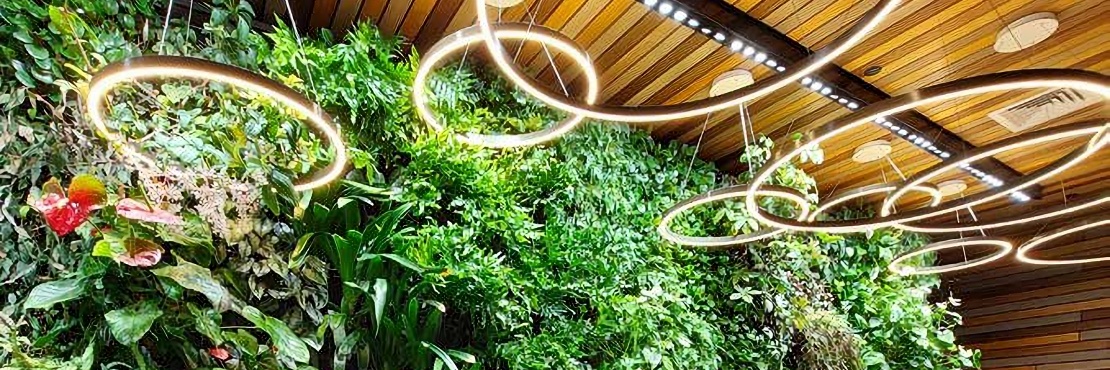Bridging the Gap between the Professional & Expert
Plants are, ever more frequently, called upon to solve challenges within indoor spaces. This extends well beyond mere aesthetic or human experience challenges. Biophilic design is a practice focusing upon connecting people with nature within the built environment, notably in terms of converting built spaces into domains catering for biological and psychological needs towards healthy outcomes.
Every day we encounter new medical and urban design publications emphasizing the requirement for people to connect with natural settings to counteract or balance challenges that arise for human health and emotional wellbeing. The built environment is inherently separated from nature and the processes that have influenced how we have evolved to function as a species.
Consequently, biophilic design and the specialist fields of vertical garden design and interior plant-scaping, are increasingly incorporated into architecture as design fields addressing human homes, offices, medical facilities, communal spaces, etc. Research is allowing this practice to become increasingly better informed.
An inherent challenge with interior gardens is the limitation on access to light which surrounding architecture may generate. Shading is impacted not only by the host building, it is exacerbated by surrounding structures and buildings as urban building densities increase both in terms of internal building fit-out densities and building footprints within the urban sphere.
Factoring in the specific requirements humans need to maintain long-term wellbeing, into well-informed design, we witness dramatic improvement in how people utilize, enjoy and value interior spaces. One such human requirement is connection with other living things, such as plants, even if only via visual access.
Internal garden design significantly increases sustainability outcomes when the requirements of plants (and by extension humans) are also factored into architectural design. The passage of sun through a day or its varying passage across the sky during seasons, impacts how light enters and interacts with building interiors.
In many cases, access to sufficient natural sunlight alone, to sustain healthy plant growth and development, is not always possible. In cases such as pre-existing buildings where architectural alterations are not an option due to engineering considerations, or within large buildings with multiple levels below ground or deep within the overall structure, the passage of natural sunlight into interior spaces may be problematic or non-existent.
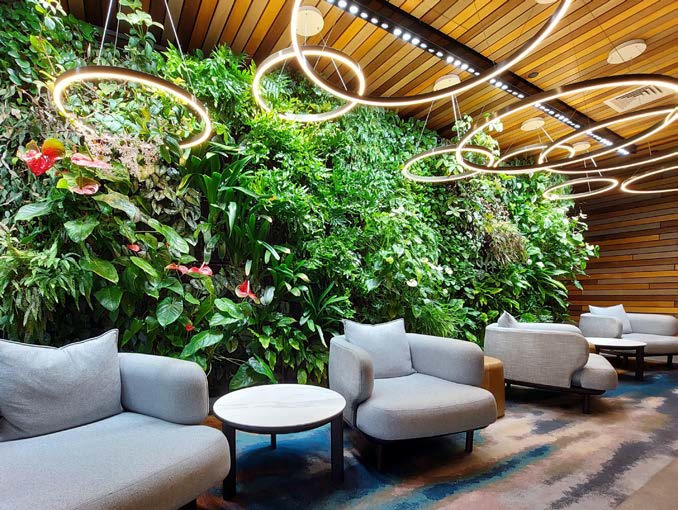
Supplementary, artificial, lighting technologies have been developed over many decades. Improvements have expanded in many directions as we deepened our understanding of how photosynthesis works and as our understanding of light has evolved.
We are constantly increasing our depth of knowledge regarding the intensity of light certain plants require to survive and thrive, the duration of exposure required to fulfill healthy daily and seasonal metabolic requirements and the quality of light required to provide sufficiently balanced energy inputs to cater for the myriad internal processes that light fuels within plants.
Why does Light seem to be a Conundrum?
As with all natural processes that have had time to evolve over eons, the deeper you investigate, greater levels of complexity become apparent. The nature of light is a challenge for many plant growers to comprehend as it manifests simultaneously both as a particle (measurable through capturing quantities of light particles, akin to grains of sand falling into your hand) and as a wavelength (measurable as changes in colour and temperature, akin to the impact of waves in water on a floating object or heat on a surface). Light is both of these simultaneously, with plants having evolved the ability to use the energy of light to create resources and to power metabolism and growth.
NATURAL SUNLIGHT AS HUMAN EYES INTERPRET IT, COMPRISES A WIDE RANGE OF COLOUR
WAVELENGTHS FROM INFRA-RED TO ULTRA-VIOLET.
Between these two outlying reference points, lie a range of colours visible to human eyes with blue, green, and yellow being examples. Yet, there are vast arrays of light wavelengths that lie beyond human eye perception. Humans see only a fraction of the light plants utilize to grow and develop.
Humans therefore only witness a small portion of the light spectrum as our senses are generally configured and calibrated to monitor what most frequently impacts our lives, such as bright sun that may scorch our skin, darkness during times when we sleep or the colour of a berry which may be either edible or poisonous.
Furthermore, the human eye has an iris, an opening through which the eye allows light to enter which our brains utilize to interpret as ‘sight’. The iris opens and closes rapidly to differing degrees, as we cast our vision across spaces, with every shadow, reflective surface, and texture variation of every object both near and far, causing our retina to open or close fractionally or to a large extent, to regulate light influx. This protects our eye from sun damage (narrowing the iris opening to limit bright light influx) and helps us regulate our sense of sight to adjust to shade (widening the iris opening to let more light in). Consequently, human eyes are not overly reliable to benchmark or compare light intensities due to the constantly fluctuating nature of our iris and our differing mental experiences of light intensities and qualities.
Furthermore, each person perceives colour a bit differently to another, depending upon the quantity and quality of cellular cone and rod structures each of our eyes hosts to perceive light with.
Measuring and matching light intensity and quality requirements to each plant species’ tolerances, requires a high level of expertise and plant knowledge, notably when many plants are utilized in high densities. Plants inherently grow; thus the process of garden maturation and expansion inherently changes light and shading, therefore understanding light requires knowledge well beyond brightness and darkness or sunlight and shade.
Thus, when architects or interior designers seek to light a human habitat, they select wavelengths and light intensities which offer the greatest benefit to humans, in terms of visual comfort and ease of engaging in activities within a space.
This artificial lighting does not cater for either human or plant needs for intense light on our skins to generate vitamins (in humans) or intense UV to enter our irises to impact human hormone levels, rather they frequently seek to provide bare minimum lighting required to provide human comfort. This does not bode well for plants, which evolved within the same environments as humans yet experience the same natural sunlight entirely differently.
An inherent challenge here lies in balancing biophilic design with plants to maximize human comfort whilst also acknowledging and providing plants with what they need.
In essence, if we provide plants with what they need, we are inherently providing humans with the greatest benefit as ideal conditions for plants generally represent environments humans evolved to live within, naturally, and to maintain healthy growth and development into the long term.
Humans have the ability to move between spaces, to seek ‘better’ conditions as days and seasons shift. Plants are mostly stationary, thus generally evolve to inhabit spaces hosting conditions that they can adapt to grow and develop in through their entire lifespan. Combining human and plant requirements into a single, appropriate, condition creates sustainable outcomes for both plants and people.
Energy consumption, design aesthetic, budget, etc. each influence how designers approach the challenges of converting dark, unhealthy, interior spaces into verdant, revitalizing, and healthy experiences for humans and plants.
Fortunately, lighting technologies are evolving rapidly, generating greater energy efficiencies, reduced costs, flexibilities to address lighting in confined spaces and the ability to tailor lighting capacities to generate more appropriate outputs allowing for better plant growth and development.
A challenge in this space is that lighting designers generally design to specifications provided by the plant specialists. Most published research is funded to support agricultural cropping of plants, which produce lighting outcomes often significantly different to what human comfort requires, such as extremely bright light or very intense coloured light to suit photosynthesis rather than human comfort.
Thus, knowledge and expertise required to produce sustainable, resilient, robust, and efficient indoor garden solutions, requires Research & Development processes and experience gained within the living architecture industry. This is often intellectual property, hard won through significant effort and protracted learning at the cost of the specialist service provider, which is not available to most growers and professionals (vs. experts).
There is no doubt that specialist knowledge and experience are required to generate cost-effective, sustainable, and appropriate lighting for plants.
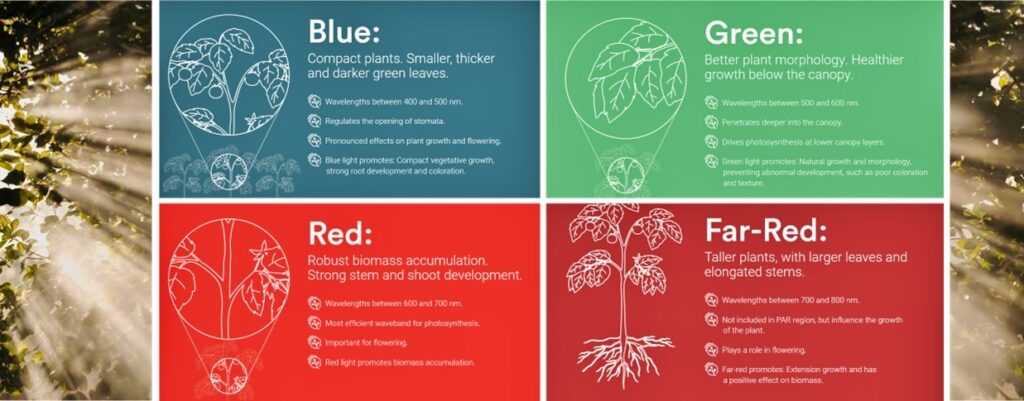
Understanding Nature
CLOSING THE DISTANCE BETWEEN ‘GETTING IT RIGHT’ & ‘GETTING IT WRONG’
HERE LIES THE KICKER: The Earth is a large space with many different climates and topographies within which plants have evolved a diverse range of unique survival techniques when it comes to harvesting and surviving off light. Not all plants are the same.
As we journey through wild spaces, we encounter different species of plants that require different intensities and different wavelengths of light. Each environment hosts a plethora of evolutionary trends and adaptations for survival. Providing plants with appropriate lighting requires knowledge of such habitats.
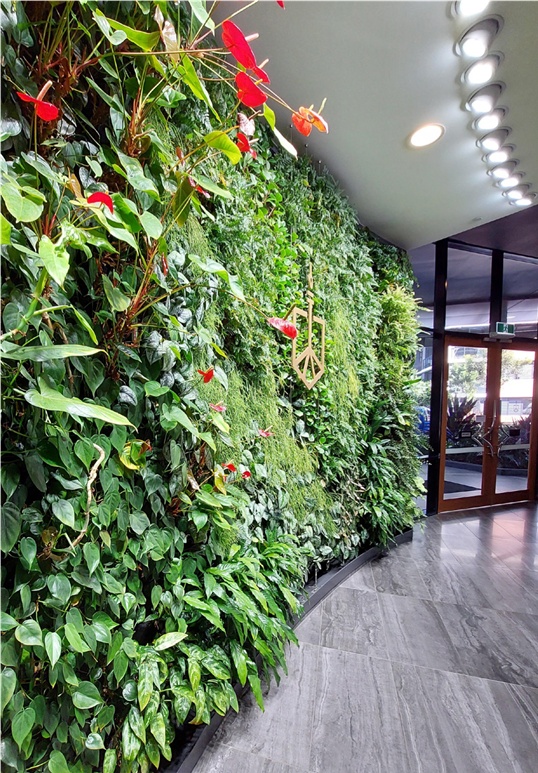 Light intensities reduce over distance between the light source and the foliage level, thus understanding how to apply light appropriately requires an intimate understanding of how light moves across & through spaces.
Light intensities reduce over distance between the light source and the foliage level, thus understanding how to apply light appropriately requires an intimate understanding of how light moves across & through spaces.
As soon as we add a plant to a location, its leaves generate shade, creating plant communities and generating complex shading patterns and community dynamics that may result in the age-old processes of life and death naturally reconfiguring plantings into outcomes balanced with available resources.
A wonderful and invaluable reality check for gardeners, plant collectors, commercial plant growers, interior designers, landscape architects and architects are a basic look at natural light intensities (measured in lux):
- Full sunlight may range to 120,000 lux
- Dappled shade through a low-density tree canopy may be 80,000 lux
- Shade through a mid-density tree canopy may be 50,000 lux
- 75% shade may be 25,000 lux
- 90% shade may be 10,000 lux
- 95% shade may be 5,000 lux
- Deep shade may be 3,000 lux (3% of full sun)
- Extremely deep shade bordering on unfeasible for most plants to survive into the longer term may be below 3,000 lux.
A SOBERING THOUGHT:
Due to the human eyes ability to adjust to light, many humans feel comfortable sitting at a desk, reading a book at 150 Lux. This is a preferred lighting intensity for an office or home relaxation space. This is not conducive to generating healthy growth and development for plants.
Interestingly, most interior vertical gardens are generally provided with 3,000 – 4,000 lux. In many cases a host wall might receive well below this along its base or perimeter where light reduces as it travels the greatest distances from the light source, or where plantings within the garden create compound shading to plantings along the garden perimeters.
Fortunately, there are plants which have evolved to survive at such levels, albeit not ideal for retaining notable health and vigour.
There are species tolerant of very deep shade exposures though many such species do not generate the vibrancy, resiliency, and longevity we hope for when planted in high densities to achieve the near 100% foliage coverage often expected for such installations.
Designing solutions within this zone of lighting, and below, require highly specialized skills and plant knowledge, which is frequently only available to those conducting direct research into this field rather than to general interior-plant scaping professionals.
Selecting your interior-scaping and vertical garden design specialist with care is a key factor in achieving success, ensuring they have the requisite depth of knowledge and expertise to cater for a range of client needs.
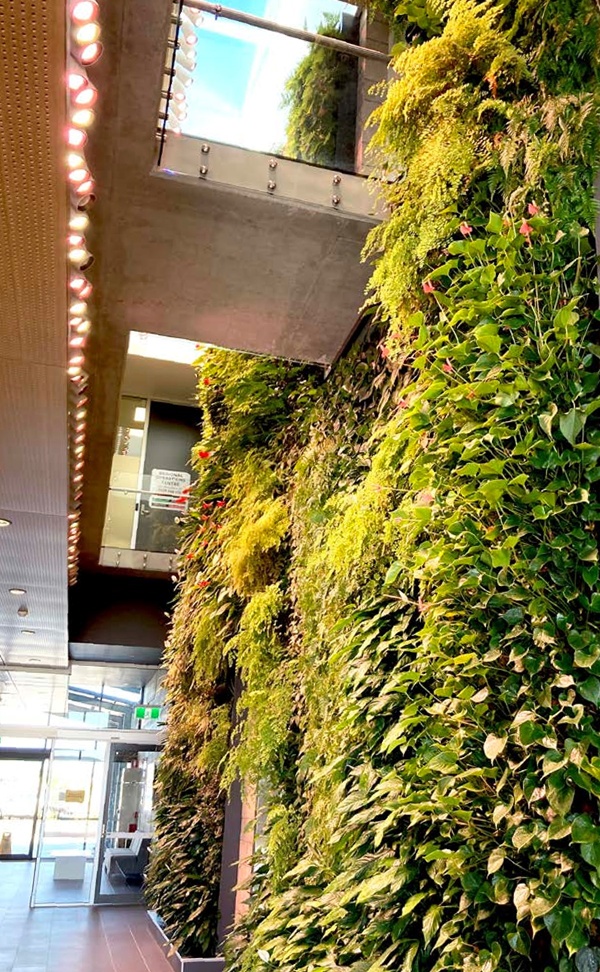 Appropriate Solutions
Appropriate Solutions
A solution well worth considering is to maximize the use of natural sunlight as a resource. This is a free resource that furthermore introduces the balance of daily and seasonal light fluctuations in ratios that are healthy to humans and plants.
Should sunlight exposures be insufficient through the day or changes in seasons, these could be supplemented with minimal inputs to boost what is already available.
In locations where no natural sunlight influx is available, lighting options are best applied in tandem with the development of the planting concept, living architecture technology and host structures architectural design. Significant efficiencies may be achieved when the living architecture specialist is brought in to accompany the design process, thus assisting in guiding all endeavors towards sustainable and appropriate outcomes. This provides design security and potential future proofing of projects, where possible.
A second solution is to improve the wavelengths (quality) of light that appropriately selected lighting technologies are able to provide to plants. This is akin to providing a well balanced diet compared to feeding larger quantities of less nutritious inputs or trying to make one survive on vitamin tablets rather than a wholesome, balanced, and sustainable diet.
As a parting thought, when considering your next interior plant-scape or vertical garden, there is wisdom in considering the host site in a holistic manner, contemplating the requirements of people and plants as shared co-inhabitors of human habitats. Select your design and installation specialist with care, query their expertise and do well to ask of their track record achieving sustainable, long-term, installations that retain their integrity without requiring repeated plant replacements.
Sustainable outcomes require working with nature, an ability to understand the underlying processes inherent to a site as resources to draw upon and apply appropriate inputs to generate elegant simplicity.
~ Erik van Zuilekom

Erik van Zuilekom is Fytogreen’s in-house Botanist and a species selection & design specialist – vertical garden & living architecture applications. Offering astute design & assessment expertise for the production of adaptive, robust & resilient (designed) ecologies. I would like to see green life ecologies deeply integrated into the urban fabric & psyche, not as passive claddings, rather as responsive technologies.
Fytogreen is Australia’s leading green infrastructure specialist and technical knowledge is gained from its targeted research and development process. Fytogreen is fortunate to be a leader in this field, with experience gained through exposure to an extensive diversity of applications, coupled with long-term monitoring of these installations.
Follow Erik on Instagram – United Natures Design
If you have a specific topic your would like covered by Erik or have any comments, please email lisa@fytogreen.com.au
 Greenroofs.comConnecting the Planet + Living Architecture
Greenroofs.comConnecting the Planet + Living Architecture
